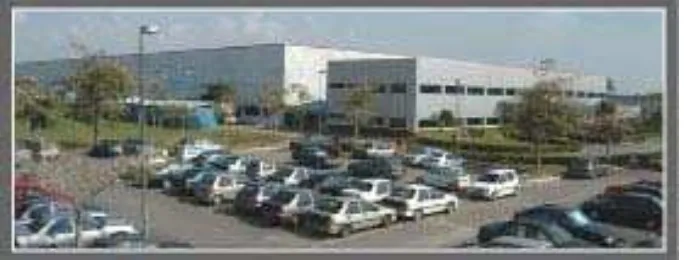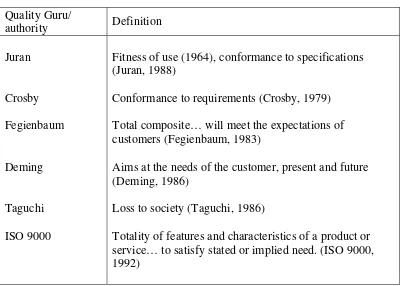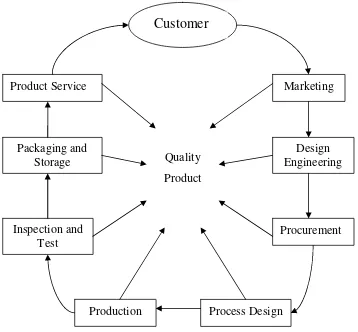UNIVERSITI TEKNIKAL MALAYSIA MELAKA
A Study on Quality Tools and Techniques based
on SWOT Analysis at CTRM AC
Thesis submitted in accordance with the requirements of Universiti Teknikal Malaysia Melaka for the Bachelor’s Degree in Manufacturing Engineering
(Manufacturing Design) with Honours
By
Sheikh Fahmi Bin Mohamed Bamadhaj
UTeM Library (Pind.1/2005)
oval
UNIVERSITI TEKNIKAL MALAYSIA MELAKA (UTeM)
BORANG PENGESAHAN STATUS TESIS*
JUDUL: A STUDY ON QUALITY TOOLS AND TECHNIQUES BASED ON SWOT ANALYSIS AT CTRM AC
SESI PENGAJIAN: 2 0 0 6 / 2 0 0 7
Saya SHEIKH FAHMI BIN MOHAMED BAMADHAJ
mengaku membenarkan t esis (PSM/ Sarj ana/ Dokt or Falsaf ah) ini disimpan di Perpust akaan Universit i Teknikal Malaysia Melaka (UTeM) dengan syarat -syarat kegunaan sepert i berikut :
1. Tesis adalah hak milik Universit i Teknikal Malaysia Melaka.
2. Perpust akaan Universit i Teknikal Malaysia Melaka dibenarkan membuat salinan unt uk t uj uan pengaj ian sahaj a.
3. Perpust akaan dibenarkan membuat salinan t esis ini sebagai bahan pert ukaran ant ara inst it usi pengaj ian t inggi.
4. **Sila t andakan (√)
SULIT
TERHAD
TIDAK TERHAD
(Mengandungi maklumat yang berdarj ah keselamat an at au kepent ingan Mal aysia yang t ermakt ub di dalam AKTA RAHSIA RASMI 1972)
(Mengandungi maklumat TERHAD yang t elah dit ent ukan oleh organisasi/ badan di mana penyelidikan dij alankan)
(TANDATANGAN PENULIS)
Alamat Tet ap:
1, LRG 3, JLN KEMUNCAK 2 TMN NONG CHIK,
80100 JOHOR BAHRU, JOHOR.
APPROVAL
This thesis submitted to the senate of UTeM and has been accepted as fulfillment of the requirement for the Degree of Bachelor of Engineering Manufacturing (Honours)
(Manufacturing Design)
The members of the supervisory committee are as follows:
……… Mr.Wan Hasrulnizzam Wan Mahmood
Project Supervisor
Faculty of Manufacturing Engineering
DECLARATION
I hereby. declared this thesis entitled “A Study on Quality Tools and
Techniques based on SWOT Analysis at CTRM AC” is the result of my own research except cited in the references.
Signature : ……… Author’s Name : Sheikh Fahmi Bin Mohamed Bamadhaj
ABSTRACT
This study discusses the quality tools and techniques used at CTRM Aero Composites (CTRM AC), Melaka. The purpose of the study is to identify and analyze the quality tools and techniques used at CTRM AC in terms of strength, weakness, opportunities and threats (SWOT). The data was gathered from primary and secondary data. The primary data includes gathering data from interviews and observations while the secondary data are literature reviews from journals, books, internet and CTRM AC quality report. From all the data collections, the result was analyzed using the SWOT analysis. The results was focused on the 7QC tools, 8D Problem Solving Technique and FMEA. Results show that the tools used at CTRM AC have their pros and cons but it is founded to be suitable for this type of industry. This is because they do not use sampling technique but inspect every part and each part is very important because it is an aircraft component. Therefore, the 7 QC tools are known as the use of statistical methods in a systematic manner to identify root causes of problem. 8D Problem Solving Techniques is to identify, correct and eliminate the recurrence of quality problems and FMEA is a method that examines potential failures in products or processes. If these three methods are used properly, the company will achieve a major success in producing products with minimal defects or quality problems.
ABSTRAK
DEDICATION
For my parents Mohamed Bamadhaj and Sharifah Noor Alhabshi and my siblings.
ACKNOWLEDGEMENTS
Assalamualaikum warahmatullahi wabarakatu
First and foremost, Alhamdulillah, thank God for giving me a chance to complete my PSM. I would also like to thank my beloved parents Mohamed S. Bamadhaj and Sharifah Noor Alhabshi, my siblings and my friends for giving me their support and motivation during my good and hard times.
Thank you to all UTeM lecturers and staffs involved in this study especially my supervisor, En. Wan Hasrulnizzam Wan Mahmood. Not forgetting all CTRM AC staffs that had been helpful in providing information needed to make this study a success. Without all of you, I could not have achieved what I have today.
Thank you again. Wassalam.
TABLE OF CONTENTS
List of Abbreviations, Symbols, Specialized Nomenclature……...………..….xii
1. INTRODUCTION...1
1.1.Introduction………...………...…..1
1.2.Company Background………2
1.2.1. Premises and Facility………...…2
1.2.2. Products………...…..…..3
1.3.Problem Statements………4
1.4.Objectives……….……..5
1.5.Scope of Study………5
1.6.Importance of Study……….………..5
1.7.Outline of Study………..……...6
2. LITERATURE REVIEW………..….7
2.1.Introduction………...…....….7
2.2.Definition of Quality………..……7
2.3.Quality Tools and Techniques…..………...…..10
2.3.1. Statistical Process Control (SPC)………..…11
2.3.1.1.Pareto Diagram………11
2.3.1.2.Cause and Effect Diagram……….……..12
2.3.1.3.Process Flow Diagram……….………13
2.3.1.4.Check Sheets………..……..14
2.3.1.5.Histogram………..………..15
2.3.1.6.Scatter Diagram………...……15
2.3.1.7.Control Charts………..16
2.3.2 Failure Mode and Effect Analysis (FMEA)………..………17
2.3.3 Quality Function Deployment (QFD)………..….19
2.3.4 Design of Experiment (DoE)……….……20
2.3.5 Quality by Design……….……….21
2.3.6 Products Liability………..…………22
2.3.7 Benchmarking………22
2.4.Summary on Quality Tools and Techniques………..…..24
3. METHODOLOGY………29
3.1.Introduction………...……….…..29
3.2.Planning of Study……….29
3.2.1. Gantt Chart………..……..31
3.4.SWOT Analysis ………..…….34
3.4.1. Strength……….…….36
4.2.Current Implementation of Quality Tools and Techniques at CTRM….……....38
4.3.Result………...…39
4.3.1. SPC – 7QC Tools………..….…...39
4.3.2. 8D (Eight Disciplines) Problem Solving Technique……….……40
5. CONCLUSION………..…………46
5.1.Introduction……….……….46
5.2.Conclusion………..…….46
5.3.Recommendation………..…………47
REFERENCES………48
LIST OF TABLES
2.1 Definitions of Quality 8
3.1 Project Planning on The Study 32
LIST OF FIGURES
1.1 CTRM AC Building 1 3
2.1 Kano’s two-dimensional recognition of Quality 9
2.2 Areas Responsible for Quality 10
2.3 Pareto Diagram 12
2.4 Cause and Effect Diagram 13
2.5 Flow Diagram for an Order Entry Activity 14
2.6 Quality Control Check Sheet 14
2.7 Sample of Histogram 15
2.8 Sample of Scatter Diagram 16
2.9 Control Chart for Strength Test 17
2.10 Design FMEA Form 18
2.11 QFD House of Quality 20
3.3 Flowchart for Planning of the Study 30
LIST OF ABBREVIATIONS, SYMBOLS, SPECIALIZED
NOMENCLATURE
7QC Tools – 7 Quality Control Tools 8D – 8 Disciplines
CNC – Computer Numerical Control
CTRM – Composites Technology Research Malaysia CTRM AC – CTRM Aero Composites
DoE – Design of Experiment
FLELP – Fixed Leading Edge Lower Panels FMEA – Failure Mode and Effect Analysis HTP TE – Horizontal Tail Plane Trailing Edge IOFLE – Inboard Outer Fixed Leading Edge
Km – Kilometer
MRO – Maintenance, Repairs and Operations QFD – Quality Function Deployment
Sdn. Bhd. – Sendirian Berhad
SPC – Statistical Process Control
SWOT – Strength, Weakness, Opportunities, Threats TPM – Total Productive Maintenance
TQM – Total Quality Management
CHAPTER 1
INTRODUCTION
1.1 Introduction
Quality has emerged and remained a dominant theme in management thinking over the past fifty years. While the initial approaches arose from American theorists and practitioners, it was predominantly Japanese companies that undertook the early commercial applications (Beckford, 2002). Besterfield (2004) stated that in the early days, most products manufactured were not complicated and quality was not affected. In fact, because productivity improved, there was a decrease in cost, which resulted in lower customer expectations. He also includes that as product became more complicated and jobs more specialized, it became necessary to inspect products after manufacture.
However, the subject area of Quality keeps advancing in both breadth and depth with the scope of application of quality tools and techniques having expended beyond the traditional manufacturing arena. Quality issues are now the concern of all organizations including the services and public sectors. Quality tools, techniques, concepts and methodologies have been enhanced and integrated with other features to suit new challenges. Today, the subject of quality is sufficient to be treated as a specialized field of study on its own (Hassan et al., 2000).
This chapter will provide an overview of the research project titled “A Study on Quality Tools and Techniques based on SWOT Analysis at CTRM AC”. The study was conducted at CTRM Aero Composites which is situated at Batu Berendam, Melaka.
1.2 Company Background
Composites Technology Research Malaysia Sdn. Bhd (CTRM) was incorporated in November 1990 by Minister of Finance Malaysia Inc. in response to the government having the vision for the advanced composite industry, thus giving CTRM the mandate to spearhead Malaysia’s foray into the aerospace and composite manufacturing. It is an investment holding company and operates through its subsidiaries (CTRM Aero Composites Sdn Bhd, CTRM Aviation Sdn Bhd and CTRM Excelnet Engineering Sdn Bhd) in various projects such as manufacturing of composite components, MRO services and engineering design.
Until August 2006, the total number of employees at CTRM is 948. CTRM Sdn Bhd focuses on three main areas: aerospace, composites and engineering. These three areas will provide the full range of the aerospace and composites industry. CTRM Aero Composites Sdn Bhd specialises in composites components manufacturing. CTRM Aviation Sdn Bhd specialises in MRO services whilst CTRM Excelnet Engineering is the group design center.
CTRM Aero Composites was established by the Malaysian Government as a vehicle for the acquisition of composite technology into Malaysia. In line of this, CTRM Aero Composites was then established as CTRM’s composites production unit to manufacture under contract and subcontract major aerospace composite components to meet its own and worldwide demand. CTRM Aero Composites production facilities is one of the most advanced of its kind in the region and will be the stepping stone for Malaysia to fully realize its vision to be the leader in the composite industry in years to come.
1.2.1 Premises and Facility
CTRM Aero Composites Sdn. Bhd., Composites Technology City, Batu Berendam, Melaka
75350 MALAYSIA
Figure 1.1: CTRM AC Building 1
The facility, specially designed for advanced composites manufacturing, consists of 20,880 sq-m which includes a factory floor area of 19,200 sq-m. Main facilities and equipment available includes walk-in freezers, coordinating measuring machine (CMM), materials drying oven, composites ply cutting machine, controlled environment laminating room, walk-in curing ovens, autoclaves, universal testing machines, non-destructive testing (ultrasonic) equipment and CNC machine.
1.2.2 Products
1. Airbus Military A400M
• Horizontal Tail Plane Trailing Edge (HTP TE)
• Vertical Tail Plane Trailing Edge (VTP TE)
• Vertical Tail Plane Leading Edge (VTP LE)
2. Airbus A380
• Fixed Leading Edge Lower Panels (FLELP)
• Inboard Outer Fixed Leading Edge (IOFLE)
3. Airbus A320
• Leading Edge Panels
• Trailing Edge Panels
• Aileron Panels
• Underwing and Overwing Panels
• Top Assembly Panels
• Moveable Fairing
• Spoiler
4. Airbus A300
• Wing Fixed Trailing Edge Assembly (FTE)
5. Airbus A318/A319/A320/A321 (A321 SERIES)
• Leading and Trailing Edge (LTE) Panel
• Trailing Edge Panels (22 panels/ ship set)
• Trailing Edge Panels ( 22 Panels/ ship set)
6. Goodrich V2500
• Phase I: Blank Cascade Actuator Cover
• Phase II: Torque Ring Fairing Torque Ring Cone
• Phase III: Outer Panel
7. Alvis Bridging
• BR90 Tactical bridging System 6-meter module launch rail using advanced composite material
1.3 Problem Statements
about the quality tools and techniques that are suitable to be used in this industry. Therefore, this study will analyze the quality tools and techniques used at CTRM AC in terms of Strength, Weakness, Opportunities and Threats (SWOT).
1.4 Objectives
Specific objectives of this study are:
1. To identify the Quality Tools and Techniques used by CTRM AC towards zero defect.
2. To analyze the Quality Tools and Techniques in terms of Strength, Weakness, Opportunities and Threats at CTRM AC.
1.5 Scope of Study
This study is prepared to identify and analyze the Quality Tools and Techniques used by CTRM AC which is situated in Melaka. The data was gathered from primary and secondary data. The primary data includes gathering data from interviews and observations while the secondary data are literature reviews from journals, books, internet and CTRM quality report. From all the data collections, the result was analyzed using the SWOT analysis technique which analyzes the quality tools and techniques used in terms of strength, weakness, opportunities and threats. The duration of this study was from December 2006 until April 2007. The results of this study may not be applicable to other industries with different operational background.
1.6 Importance of Study
The importance of this study is as follows:
1. A starting point in terms of defining the ultimate quality tool and technique that should be used for CTRM and other aerospace industry.
2. As academic references for Universities and Colleges in subjects that are related to quality.
3. Readers can gain knowledge in quality and use as reference in related studies.
1.7 Outline of Study
This study is divided into five (5) chapters. Chapter 1 is mainly about the introduction which consists of the company background, problem statements, objectives, scope of study, importance of study and the outline of the study. Chapter 2 is the literature review. This chapter discusses the definition and gives and introduction to the key words which is quality based on the references gathered.
Chapter 3 is the methodology. This chapter explains the research methodologies that were used to gather the data to support the analysis of the study. The methodology includes the planning of the study, survey instrument, flowchart of the study, data collection and analysis technique.
CHAPTER 2
LITERATURE REVIEW
2.1 Introduction
This chapter provides the definitions of the key word which is quality. A detailed description on quality is also provided in order to give an understanding about the philosophy. Other than that, since this study is focusing on the quality tools and techniques, the basic quality tools and techniques is also explained in this chapter.
2.2 Definition of Quality
Quality has been defined differently by different people. The essences of some definitions are summarized in Table 2.1 (Hassan et al., 2000). Quality is the result of a comparison between what was required and what was provided. It is judged not by the producer but by the receiver. The judgment can be made of an intention, as is the case when selecting suppliers, or an output, as is the case when purchasing a product or service (Institute of Quality Assurance, 2006).
Quality is not perfection, a standard, a procedure, a measure or an adjective. No amount of inspection changes the quality of a product or service. Quality does not exist in isolation - there has to be an entity, the quality of which is being discussed. Quality is not a specific characteristic of an entity but the extent to which that characteristic meets certain needs. The value of the characteristic is unimportant - it is how its value compares with customer needs that signify its quality (Institute of Quality Assurance, 2006).
Table 2.1: Definitions of Quality
Fitness of use (1964), conformance to specifications (Juran, 1988)
Conformance to requirements (Crosby, 1979) Total composite… will meet the expectations of customers (Fegienbaum, 1983)
Aims at the needs of the customer, present and future (Deming, 1986)
Loss to society (Taguchi, 1986)
Totality of features and characteristics of a product or service… to satisfy stated or implied need. (ISO 9000, 1992)
Degree of Availability
Unexpected
Expected MUST BE
QUALITY
ATTRACTIVE
QUALITY Customer
Satisfaction
Figure 2.1: Kano’s two-dimensional recognition of Quality (Kano et al., 1984)
The responsibility for quality is delegated to the various areas with the authority to make quality decisions. In addition, a method of accountability, such as cost, error rate, or nonconforming units, is included with that responsibility and authority. The area responsible for quality control is shown in Figure 2.2. They are marketing, design engineering, procurement, process design, production, inspection and test, packaging and storage, product service, and the customer. Figure 2.2 is a close loop with the customer at the top and the areas in the proper sequence in the loop.
Customer
Production Process Design
Procurement
Figure 2.2: Areas Responsible for Quality (Besterfield, 2004)
2.3 Quality Tools and Techniques


